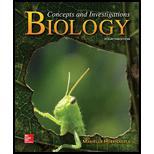
What is the advantage of a four-chambered heart?
- a. It uses the least energy of any type of heart.
- b. It maximizes the amount of O2 reaching tissues.
- c. It enhances the mixing of blood from the pulmonary and systemic circulation.
- d. Both a and c are correct.
Introduction:
Human heart is a muscular organ which is responsible for transportation of oxygen and nutrients through blood. It pumps blood through blood vessels. It is also involve in the removal of carbon dioxide and other metabolic waste out of the body. It is located between the lungs and in the middle of chest.
Answer to Problem 1MCQ
Correct answer:
The presence of four chambered heart helps in the transportation of oxygen in tissues. Therefore option (b) is correct.
Explanation of Solution
Reason for the correct statement
The four chambered heart has two chambers which receive deoxygenated blood from whole body and pump that blood to lungs for purification while the other two chambers are responsible for the receiving oxygenated blood from lungs and pumped it into whole bodies through blood vessels. With the help of four chamber heart the deoxygenated blood is easily collected from body and fulfills the oxygen demand of body.
Option (b) is given as “It maximizes the amount of
As, “the four chambered heart detoxify and deoxygenated blood and fulfill the oxygen demand of body”, is the right answer.
Hence, option (b) is correct.
Reasons for the incorrect statements:
Option (a), is given as “It uses the least energy of any type of heart”.
The contraction of heart is guided by the actin and myosin filament that are sliding over each other. It is carried out by sliding movement and it generates ATP for the movement of cardiac muscle. Hence, it is a wrong answer.
Option (c), is given as “It enhances the mixing of blood from pulmonary and systemic circulation”.
The four chambered heart helps in prevention of mixing of deoxygenated and oxygenated blood as the deoxygenated blood is carried out by vena cava and pumps it to lungs for purification. Hence, it is a wrong answer.
Option (d), is given as “Both a and c are correct”
The four chambered heart carries deoxygenated and oxygenated blood and it pumps the deoxygenated blood into lungs for purification and after purification it collects oxygenated blood from lungs and pumped it to other parts of body. Hence, it is a wrong answer.
Hence, options (a), (c), and (d), are incorrect.
The heart has four chambers, two chambers carry deoxygenated blood from body and transfer it to lungs and receives oxygenated blood from lungs and transfer to the whole body.
Want to see more full solutions like this?
Chapter 30 Solutions
Biology: Concepts and Investigations
Additional Science Textbook Solutions
Introductory Chemistry (6th Edition)
Laboratory Manual For Human Anatomy & Physiology
Organic Chemistry
SEELEY'S ANATOMY+PHYSIOLOGY
Biology: Life on Earth with Physiology (11th Edition)
- Molecular Biology Question A gene that codes for a protein was removed from a eukaryotic cell and inserted into a prokaryotic cell. Although the gene was successfully transcribed and translated, it produced a different protein than it produced in the eukaryotic cell. What is the most likely explanation?arrow_forwardMolecular Biology LIST three characteristics of origins of replicationarrow_forwardMolecular Biology Question Please help. Thank you For E coli DNA polymerase III, give the structure and function of the b-clamp sub-complex. Describe how the structure of this sub-complex is important for it’s function.arrow_forward
- Molecular Biology LIST three characteristics of DNA Polymerasesarrow_forwardMolecular Biology RNA polymerase core enzyme structure contains what subunits? To form holo enzyme, sigma factor is added to core. What is the name of the structure formed? Give the detailed structure of sigma factor and the function of eachdomain. Please help. Thank youarrow_forwardMolecular Biology You have a single bacterial cell whose DNA is labelled with radioactiveC14. After 5 rounds of cell division, how may cells will contain radioactive DNA? Please help. Thank youarrow_forward
- 1. Explain the structure and properties of atoms and chemical bonds (especially how they relate to DNA and proteins). Also add some pictures.arrow_forward1. In the Sentinel Cell DNA integrity is preserved through nanoscopic helicase-coordinated repair, while lipids in the membrane are fortified to resist environmental mutagens. also provide pictures for this question.arrow_forwardExplain the structure and properties of atoms and chemical bonds (especially how they relate to DNA and proteins). Also add some pictures.arrow_forward
- In the Sentinel Cell DNA integrity is preserved through nanoscopic helicase-coordinated repair, while lipids in the membrane are fortified to resist environmental mutagens. also provide pictures for this question.arrow_forward1. Explain how genetic information is stored, copied, transferred, and expressed. Also add some pictures for this question.arrow_forward!. Describe biological macromolecules (DNA, RNA, proteins, lipids, etc.) and how they function in the cell. also provide some images for this question.arrow_forward
 Comprehensive Medical Assisting: Administrative a...NursingISBN:9781305964792Author:Wilburta Q. Lindh, Carol D. Tamparo, Barbara M. Dahl, Julie Morris, Cindy CorreaPublisher:Cengage Learning
Comprehensive Medical Assisting: Administrative a...NursingISBN:9781305964792Author:Wilburta Q. Lindh, Carol D. Tamparo, Barbara M. Dahl, Julie Morris, Cindy CorreaPublisher:Cengage Learning Biology (MindTap Course List)BiologyISBN:9781337392938Author:Eldra Solomon, Charles Martin, Diana W. Martin, Linda R. BergPublisher:Cengage Learning
Biology (MindTap Course List)BiologyISBN:9781337392938Author:Eldra Solomon, Charles Martin, Diana W. Martin, Linda R. BergPublisher:Cengage Learning





